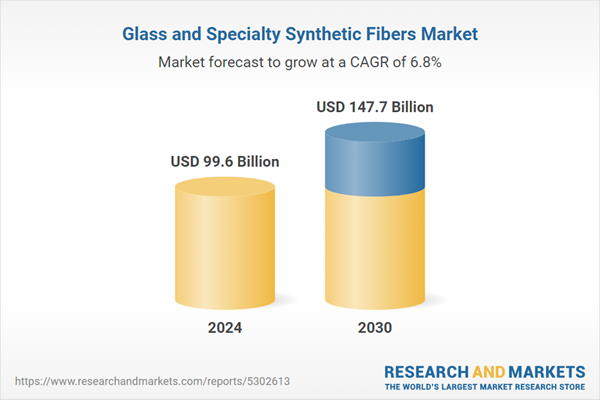The global market for Glass and Specialty Synthetic Fibers was valued at US$99.6 Billion in 2024 and is projected to reach US$147.7 Billion by 2030, growing at a CAGR of 6.8% from 2024 to 2030. This comprehensive report provides an in-depth analysis of market trends, drivers, and forecasts, helping you make informed business decisions. The report includes the most recent global tariff developments and how they impact the Glass and Specialty Synthetic Fibers market.
Segments: Fiber Type (Glass, Carbon, Aramid, Ultra-High Molecular Weight Polyethylene (UHMWPE) Fibers, Polyphenylene Sulfide (PPS) Fibers, Other Fiber Types); End-Use (Aerospace & defense, Wind Energy, Transportation, Construction & Infrastructure, Marine, Other End-Uses); Application (Composite, Non-Composite).
Geographic Regions/Countries: World; United States; Canada; Japan; China; Europe (France; Germany; Italy; United Kingdom; Spain; Russia; and Rest of Europe); Asia-Pacific (Australia; India; South Korea; and Rest of Asia-Pacific); Latin America (Argentina; Brazil; Mexico; and Rest of Latin America); Middle East (Iran; Israel; Saudi Arabia; United Arab Emirates; and Rest of Middle East); and Africa.
The analysts continuously track trade developments worldwide, drawing insights from leading global economists and over 200 industry and policy institutions, including think tanks, trade organizations, and national economic advisory bodies. This intelligence is integrated into forecasting models to provide timely, data-driven analysis of emerging risks and opportunities.
Global Glass and Specialty Synthetic Fibers Market - Key Trends and Drivers Summarized
How Are Glass and Specialty Synthetic Fibers Transforming Modern Industries?
Glass and specialty synthetic fibers are critical materials used across a wide range of industries, including construction, automotive, aerospace, and telecommunications. Known for their high strength-to-weight ratio, thermal resistance, and corrosion resistance, these fibers are widely used in the production of composites, insulation, and reinforcement materials. Glass fibers are particularly prominent in the construction sector, where they are used to reinforce concrete and other building materials, while specialty synthetic fibers, such as aramid and carbon fibers, are essential in high-performance applications like aerospace and defense. These fibers are also extensively used in telecommunications, where they form the backbone of fiber-optic cables, enabling high-speed data transmission.What Are the Key Segments of the Glass and Specialty Synthetic Fibers Market?
Glass fibers are typically classified into types such as E-glass and S-glass, with E-glass being the most common due to its affordability and excellent insulating properties. Specialty synthetic fibers include aramid, carbon, and UHMWPE fibers, each offering unique mechanical and chemical properties. Key applications include composites in automotive and aerospace, insulation materials in construction, and fiber optics in telecommunications. The end-use industries driving demand for these fibers include construction, automotive, telecommunications, aerospace, and defense. North America and Europe are leading markets due to high demand for advanced materials, while Asia-Pacific is witnessing rapid growth due to increasing infrastructure and industrialization efforts.How Are Technological Innovations Enhancing Glass and Specialty Synthetic Fibers?
Technological advancements in material science are continuously improving the performance and versatility of glass and specialty synthetic fibers. Innovations in fiber production techniques, such as the use of nanotechnology and advanced weaving methods, are resulting in stronger, lighter, and more durable fibers. These advancements are expanding the use of fibers in high-performance applications, such as aerospace components and military protective gear. In addition, the development of hybrid fibers, which combine the properties of glass and synthetic fibers, is opening new possibilities for multi-functional materials that can offer improved strength, flexibility, and thermal resistance. Sustainable production methods, such as the recycling of fiber materials, are also becoming more prominent as industries strive to reduce their environmental footprint.What Factors Are Driving the Growth in the Glass and Specialty Synthetic Fibers Market?
The growth in the glass and specialty synthetic fibers market is driven by several factors, including the increasing demand for lightweight, high-strength materials in industries such as automotive, aerospace, and construction. The rise of electric vehicles and the need for fuel-efficient transportation are pushing manufacturers to adopt composite materials reinforced with glass and synthetic fibers. In the construction sector, the growing focus on sustainable and energy-efficient building materials is fueling demand for fiber-reinforced concrete and insulation products. Technological advancements in fiber-optic networks, driven by the expansion of 5G and high-speed internet, are further boosting the market. Additionally, the growing use of specialty synthetic fibers in defense, aerospace, and industrial applications is creating new opportunities for market growth.Report Scope
The report analyzes the Glass and Specialty Synthetic Fibers market, presented in terms of units. The analysis covers the key segments and geographic regions outlined below.Segments: Fiber Type (Glass, Carbon, Aramid, Ultra-High Molecular Weight Polyethylene (UHMWPE) Fibers, Polyphenylene Sulfide (PPS) Fibers, Other Fiber Types); End-Use (Aerospace & defense, Wind Energy, Transportation, Construction & Infrastructure, Marine, Other End-Uses); Application (Composite, Non-Composite).
Geographic Regions/Countries: World; United States; Canada; Japan; China; Europe (France; Germany; Italy; United Kingdom; Spain; Russia; and Rest of Europe); Asia-Pacific (Australia; India; South Korea; and Rest of Asia-Pacific); Latin America (Argentina; Brazil; Mexico; and Rest of Latin America); Middle East (Iran; Israel; Saudi Arabia; United Arab Emirates; and Rest of Middle East); and Africa.
Key Insights:
- Market Growth: Understand the significant growth trajectory of the Glass segment, which is expected to reach US$42.3 Billion by 2030 with a CAGR of a 8.0%. The Carbon segment is also set to grow at 6.9% CAGR over the analysis period.
- Regional Analysis: Gain insights into the U.S. market, valued at $26.0 Billion in 2024, and China, forecasted to grow at an impressive 10.0% CAGR to reach $34.3 Billion by 2030. Discover growth trends in other key regions, including Japan, Canada, Germany, and the Asia-Pacific.
Why You Should Buy This Report:
- Detailed Market Analysis: Access a thorough analysis of the Global Glass and Specialty Synthetic Fibers Market, covering all major geographic regions and market segments.
- Competitive Insights: Get an overview of the competitive landscape, including the market presence of major players across different geographies.
- Future Trends and Drivers: Understand the key trends and drivers shaping the future of the Global Glass and Specialty Synthetic Fibers Market.
- Actionable Insights: Benefit from actionable insights that can help you identify new revenue opportunities and make strategic business decisions.
Key Questions Answered:
- How is the Global Glass and Specialty Synthetic Fibers Market expected to evolve by 2030?
- What are the main drivers and restraints affecting the market?
- Which market segments will grow the most over the forecast period?
- How will market shares for different regions and segments change by 2030?
- Who are the leading players in the market, and what are their prospects?
Report Features:
- Comprehensive Market Data: Independent analysis of annual sales and market forecasts in US$ Million from 2024 to 2030.
- In-Depth Regional Analysis: Detailed insights into key markets, including the U.S., China, Japan, Canada, Europe, Asia-Pacific, Latin America, Middle East, and Africa.
- Company Profiles: Coverage of players such as AGY, Chongqing Polycomp International Corporation, DSM, E. I. Du Pont Nemours & Co., Hexcel Corporation and more.
- Complimentary Updates: Receive free report updates for one year to keep you informed of the latest market developments.
Some of the 43 companies featured in this Glass and Specialty Synthetic Fibers market report include:
- AGY
- Chongqing Polycomp International Corporation
- DSM
- E. I. Du Pont Nemours & Co.
- Hexcel Corporation
- Honeywell International, Inc.
- Jushi Group Co., Ltd.
- Kuraray Co., Ltd.
- Mitsubishi Chemical Holdings Corporation
- Nippon Electric Glass Co., Ltd.
- Owens Corning
- SGL Group
- Taishan Fiberglass, Inc. (CTG)
- Teijin Limited
- Toray Industries, Inc.
Tariff Impact Analysis: Key Insights for 2025
Global tariff negotiations across 180+ countries are reshaping supply chains, costs, and competitiveness. This report reflects the latest developments as of April 2025 and incorporates forward-looking insights into the market outlook.The analysts continuously track trade developments worldwide, drawing insights from leading global economists and over 200 industry and policy institutions, including think tanks, trade organizations, and national economic advisory bodies. This intelligence is integrated into forecasting models to provide timely, data-driven analysis of emerging risks and opportunities.
What’s Included in This Edition:
- Tariff-adjusted market forecasts by region and segment
- Analysis of cost and supply chain implications by sourcing and trade exposure
- Strategic insights into geographic shifts
Buyers receive a free July 2025 update with:
- Finalized tariff impacts and new trade agreement effects
- Updated projections reflecting global sourcing and cost shifts
- Expanded country-specific coverage across the industry
Table of Contents
I. METHODOLOGYII. EXECUTIVE SUMMARY2. FOCUS ON SELECT PLAYERSIII. MARKET ANALYSISCANADAITALYSPAINRUSSIAREST OF EUROPESOUTH KOREAREST OF ASIA-PACIFICARGENTINABRAZILMEXICOREST OF LATIN AMERICAIRANISRAELSAUDI ARABIAUNITED ARAB EMIRATESREST OF MIDDLE EASTIV. COMPETITION
1. MARKET OVERVIEW
3. MARKET TRENDS & DRIVERS
4. GLOBAL MARKET PERSPECTIVE
UNITED STATES
JAPAN
CHINA
EUROPE
FRANCE
GERMANY
UNITED KINGDOM
ASIA-PACIFIC
AUSTRALIA
INDIA
LATIN AMERICA
MIDDLE EAST
AFRICA
Companies Mentioned (Partial List)
A selection of companies mentioned in this report includes, but is not limited to:
- AGY
- Chongqing Polycomp International Corporation
- DSM
- E. I. Du Pont Nemours & Co.
- Hexcel Corporation
- Honeywell International, Inc.
- Jushi Group Co., Ltd.
- Kuraray Co., Ltd.
- Mitsubishi Chemical Holdings Corporation
- Nippon Electric Glass Co., Ltd.
- Owens Corning
- SGL Group
- Taishan Fiberglass, Inc. (CTG)
- Teijin Limited
- Toray Industries, Inc.
Table Information
| Report Attribute | Details |
|---|---|
| No. of Pages | 94 |
| Published | April 2025 |
| Forecast Period | 2024 - 2030 |
| Estimated Market Value ( USD | $ 99.6 Billion |
| Forecasted Market Value ( USD | $ 147.7 Billion |
| Compound Annual Growth Rate | 6.8% |
| Regions Covered | Global |









